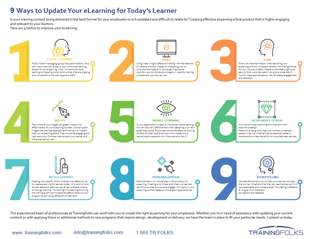eLearning Company Insight: How has eLearning Evolved?

When eLearning started to be used in regular commercial businesses about 30 years ago, the only companies that could afford to create and sustain this new learning format were very large organizations. There was an argument for about 20 of those years about whether or not eLearning was as effective in training employees as face-to-face training. (Short answer, yes!)
Nevertheless, most organizations had a tough time justifying the expense of time, effort, and money that it took to create courses that inevitably had to be updated or fully changed because of changes in the organization or content.
Recently (read, 15 years ago) tool creators started to create tools and systems that allowed for much more efficient use of content, programming and distribution channels, making eLearning much more ubiquitous. The use of eLearning was vastly improved when internet speeds and distribution improved as well.
Today (in the past 5 years) these tools for creating eLearning, media, and other information distribution have become remarkably easy to use and deliver to end-users. Also today, (the past 2 years) due to the global pandemic, online learning has become the focus of everyone globally as we all struggle to meet the learning needs of our children, employees, customers, and the world in general.
So, what does eLearning look like today? As an eLearning development company, it is shorter, more personalized, and media rich by comparison to even 5 years ago. It is also less impactful in some ways, ‘noisier’, and less about learning in some cases. eLearning is still a valuable tool in an organization’s learning and development toolset; something which is not likely to change as we continue to work in an increasingly more distributed and distracted world.
Smaller and more concise
Educational psychologists and marketers alike have known for years that human beings have a defined attention span. (No, it isn’t 3 seconds, and it hasn’t decreased over time, if you’ve been reading eLearning myths.) That said, the ‘discovery’ that learning should be short and consumed with one fact, idea, or skill at a time, is a recent development in the world of corporate learning. This is something that has improved eLearning development. Long gone are the days of 2-hour sessions of courseware covering everything about a system all at once. Also gone are the days of having to take endless exams at the end of the course to prove that you had been listening to the recording or clicking ‘next’ to get to the assessment.
eLearning today is focused on presenting small pieces of information that are easy to understand and apply, delivered in the moment of need, and hopefully in a place that is not just the organization’s formal learning management system (LMS). With the development of tools that allow for the publishing of content that sits and plays well with an LMS but can also sit as an HTML5 page in a knowledge center (such as Microsoft Teams or One Note, or Atlassian’s Confluence for example).
Advancement in Tools
The advancement of rapid eLearning authoring tools is democratizing the creation of eLearning and media rich content to everyone. Content creation is not limited anymore to programmers and developers or learning professionals. The benefit of this is that content can be rapidly created and distributed to internal and external networks without having to get budgets, resources, and professionals lined up and approved.
Of course, the drawback of rapid eLearning authoring tools is that what is created isn’t necessarily learning as much as it might be communication. Additionally, it may not be easy to consume without the professional input of instructional designers or adult learning experts. Learning design is a skill that needs to be employed when developing learning. It is as much a science, rooted in adult psychology, learning theory and human behavior research as it is an art, with its delivery using graphics, video, writing, and visual design.
Advancements in tools also reach the delivery of eLearning. The previous generation of learning management systems was heavily centered around the delivery of structured formal learning. They were database driven and developed largely by IT teams.
Newer LMS systems that have ended up in distributed models (aka ‘the cloud’) are still structurally the same as the old LMS’s but they also have the advantage of being available on any device as long as there is a stable Internet connection. Additionally, newer systems allow for training to be both mandatory and self-enrolled, which advances talent development and personal learning opportunities. Of course, this traditional system is still only delivering what the organization has determined is learning.
The newest learning systems (learning Experience Platforms, or LXPs) help to connect learners with content provided by the organization, connected learning from other platforms that the organization has added, and personal learning experiences such as journals or active learning experiences, and other media. This newest version of the delivery system will enable learners to grow and develop in many ways, not just traditionally developed content delivered one-way.
Expectations of performance of the tools supporting eLearning courses have changed
While the tools have changed how eLearning is built and delivered, learners’ expectations have also changed with what is delivered. Today’s eLearning consumers are expecting that their learning experiences are either very similar or better than their experiences with user-driven content in other places (like video or social media platforms) or they are expecting it to be tailored to their needs. This has two effects: it lowers the bar for video-based content, and it raises the bar for designed learning experiences. So having your senior vice president of sales produce a video about the most difficult contract they negotiated and how they succeeded looking like a social media post is completely acceptable, but having your professional individual contributor take a refresher course designed for the whole department might not be. As a result, learning is getting smaller so that some content can be ‘skipped’ or tested out.
A new set of opposing ‘camps’ have emerged as well: those who are looking for a highly engaging and participatory experience and those who want to reference material and consume their learning completely in their own way – using reference materials, how to videos, or examples they can witness.
Finally, as machine intelligence rises and heuristics (blandly called artificial intelligence) are creating opportunities for learning organizations to analyze and serve a greater more personalized experience, but at what cost? By employing rules that show the learner more of what they have already been learning, you potentially limit the breadth of learning that may be most beneficial to their role or the overall outcomes of the organization.
Using professional learning consultants
Just like organizational mapping, business planning, or budgeting, professional learning consultants are available and much more prevalent in the corporate world today than even five years ago. A learning professional can help balance the needs of the organization with the needs of the individual as well as providing guidance on new technologies in learning design and deployment. What’s more, they also understand the psychology of learning and can help design even informal learning environments that capture the culture and requirements of the organization to move forward.
Just like the personal entertainment world, eLearning and online learning experiences have evolved quickly in the past year but not just in the number and ease of tool use; also in the way people see eLearning and use it for their personal benefit.
Want to modernize your eLearning offering, but not sure where to begin?
Get out FREE Download: '9 Ways to Update your eLearning for Todays Learner'


